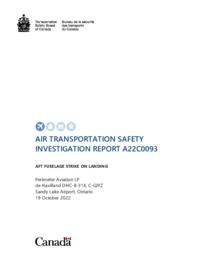
| Date: | Wednesday 19 October 2022 |
| Time: | 21:58 |
| Type: |  de Havilland Canada DHC-8-314 Dash 8 |
| Owner/operator: | Perimeter Aviation |
| Registration: | C-GJYZ |
| MSN: | 368 |
| Year of manufacture: | 1994 |
| Engine model: | Pratt & Whitney Canada PW123B |
| Fatalities: | Fatalities: 0 / Occupants: 31 |
| Other fatalities: | 0 |
| Aircraft damage: | Substantial |
| Category: | Accident |
| Location: | Sandy Lake Airport, ON (ZSJ) -
 Canada Canada
|
| Phase: | Landing |
| Nature: | Passenger - Scheduled |
| Departure airport: | Pikangikum Airport, ON (YPM/CYPM) |
| Sandy Lake Airport, ON (ZSJ/CZSJ) | |
| Investigating agency: | TSB |
| Confidence Rating: |
Perimeter Aviation flight 664, a DHC-8-314 aircraft, suffered a tailstrike while landing on runway 29 at Sandy Lake (CZSJ), ON.
At 21:58 local time during the nighttime landing on tunway 29, the aircraft’s main landing gear made contact with the runway approximately 350 feet past the runway threshold. The aircraft bounced and briefly became airborne again as the first officer, who was the pilot flying, attempted to continue the landing. He pitched the aircraft up in an attempt to soften the ensuing touchdown. After the aircraft touched down firmly for a second time, he indicated that he would go-around and began increasing the throttles. The captain, who was the pilot monitoring, noticed that an aft fuselage strike had occurred and took control of the aircraft, bringing the throttles to idle. He completed the landing roll with approximately 1600 feet of runway remaining and proceeded to taxi normally to the apron.
There were no confirmed injuries. There was significant damage to the lower aft fuselage structure of the aircraft.
Findings as to causes and contributing factors:
1. Below 500 feet above ground level and while trying to intercept and maintain the appropriate approach path, the pilot flying varied the power setting between 57% and flight idle, likely owing to limited experience operating the aircraft type, and the result was an unstable approach.
2. Due to insufficient detail in the standard operating procedures and the absence of awareness training on stabilized approach criteria, the pilots did not recognize that significant variations in the power setting had made the approach unstable, and they continued the approach.
3. The pilot flying, who was relatively inexperienced on the DHC-8 and had received limited guidance on pitch awareness, made a pronounced pitch-up input during the flare. There was insufficient time for the pilot monitoring to arrest this action, and the aircraft’s aft fuselage consequently contacted the runway, causing significant damage.
Accident investigation:
 |
|
Sources:
TSB A22C0093
Location
Revision history:
| Date/time | Contributor | Updates |
|---|---|---|
| 26-May-2024 06:08 | ASN | Updated [Time, Narrative, Accident report] |
| 26-May-2024 06:11 | ASN | Updated [[Time, Narrative, Accident report]] |
The Aviation Safety Network is an exclusive service provided by:


 ©2024 Flight Safety Foundation
©2024 Flight Safety Foundation